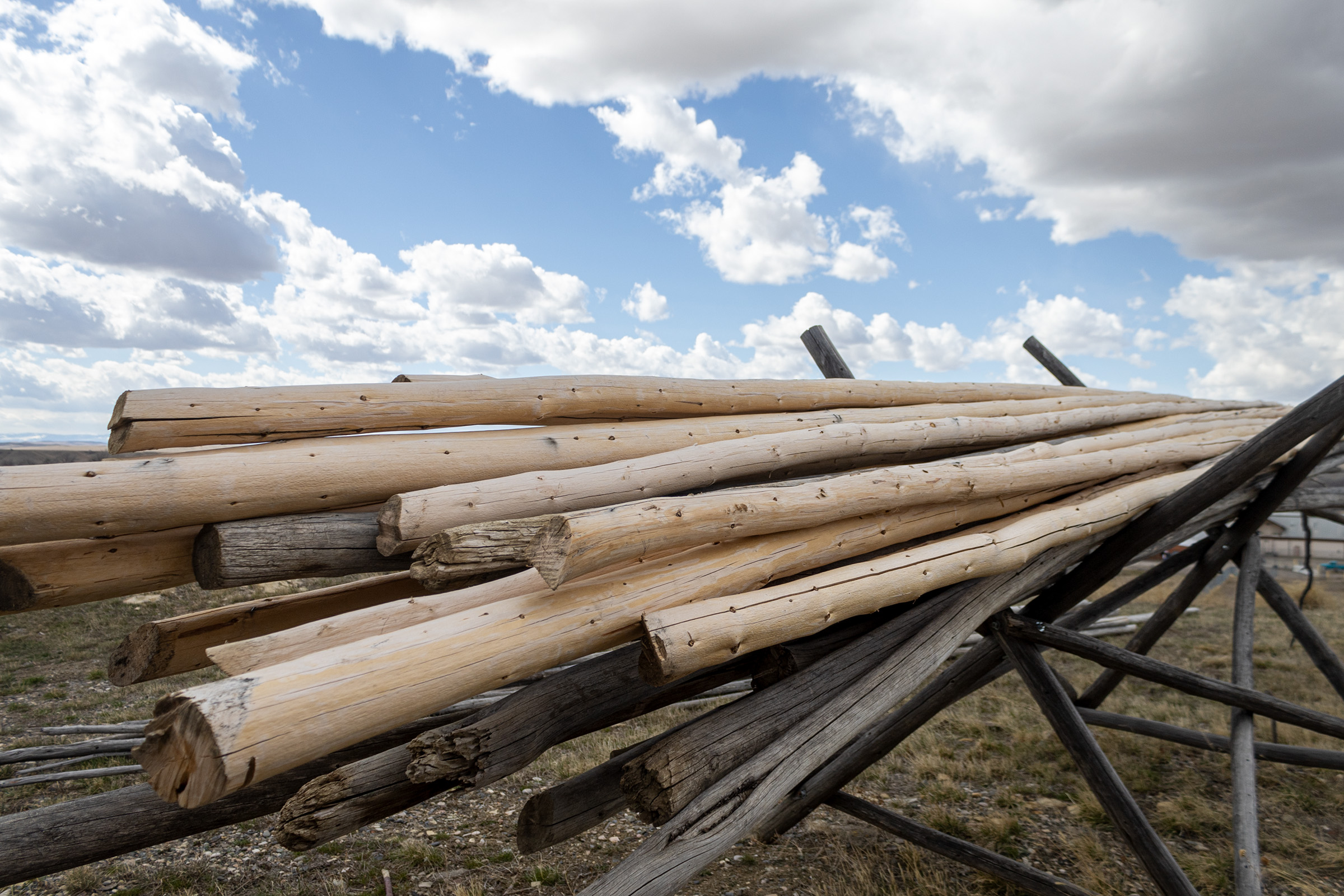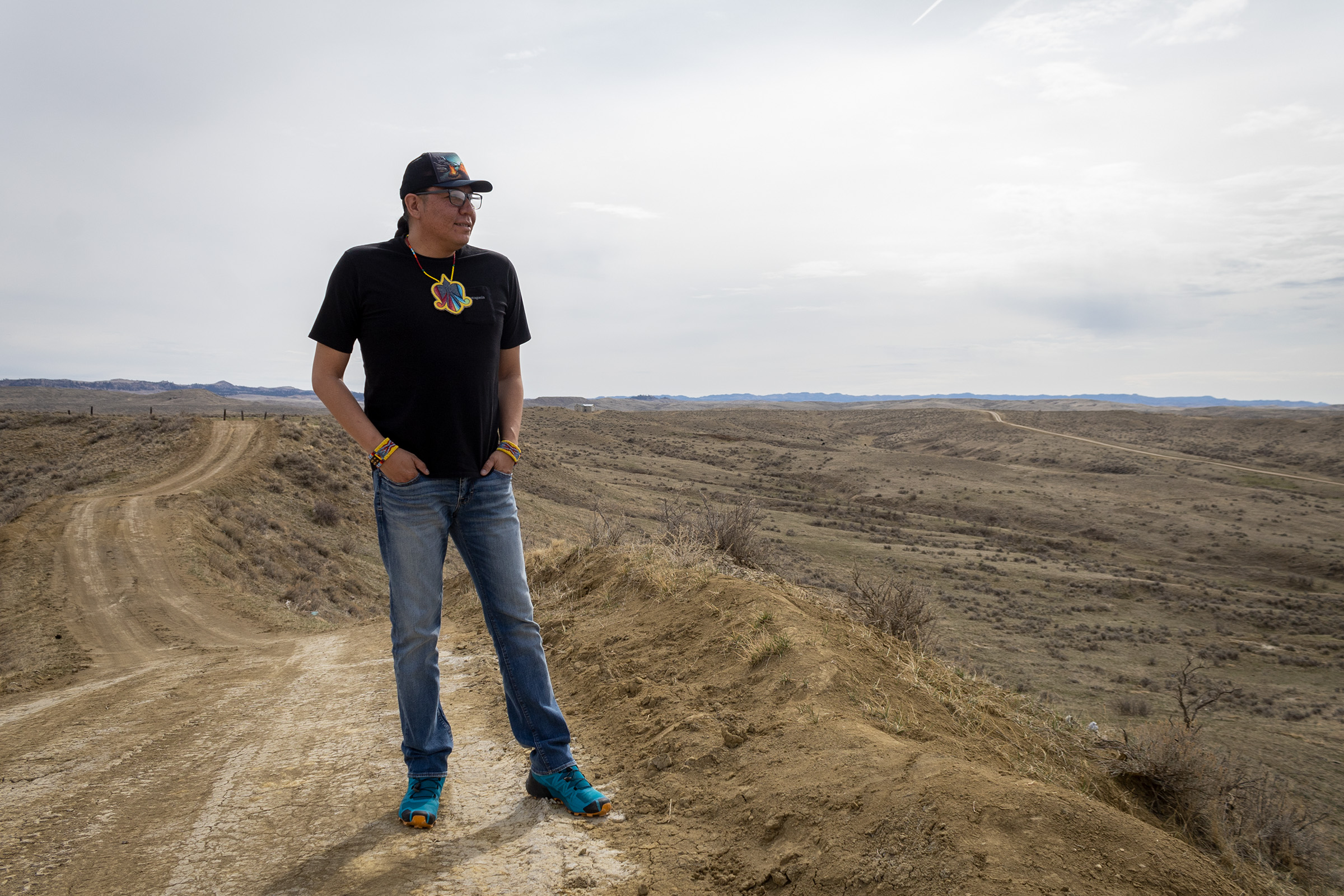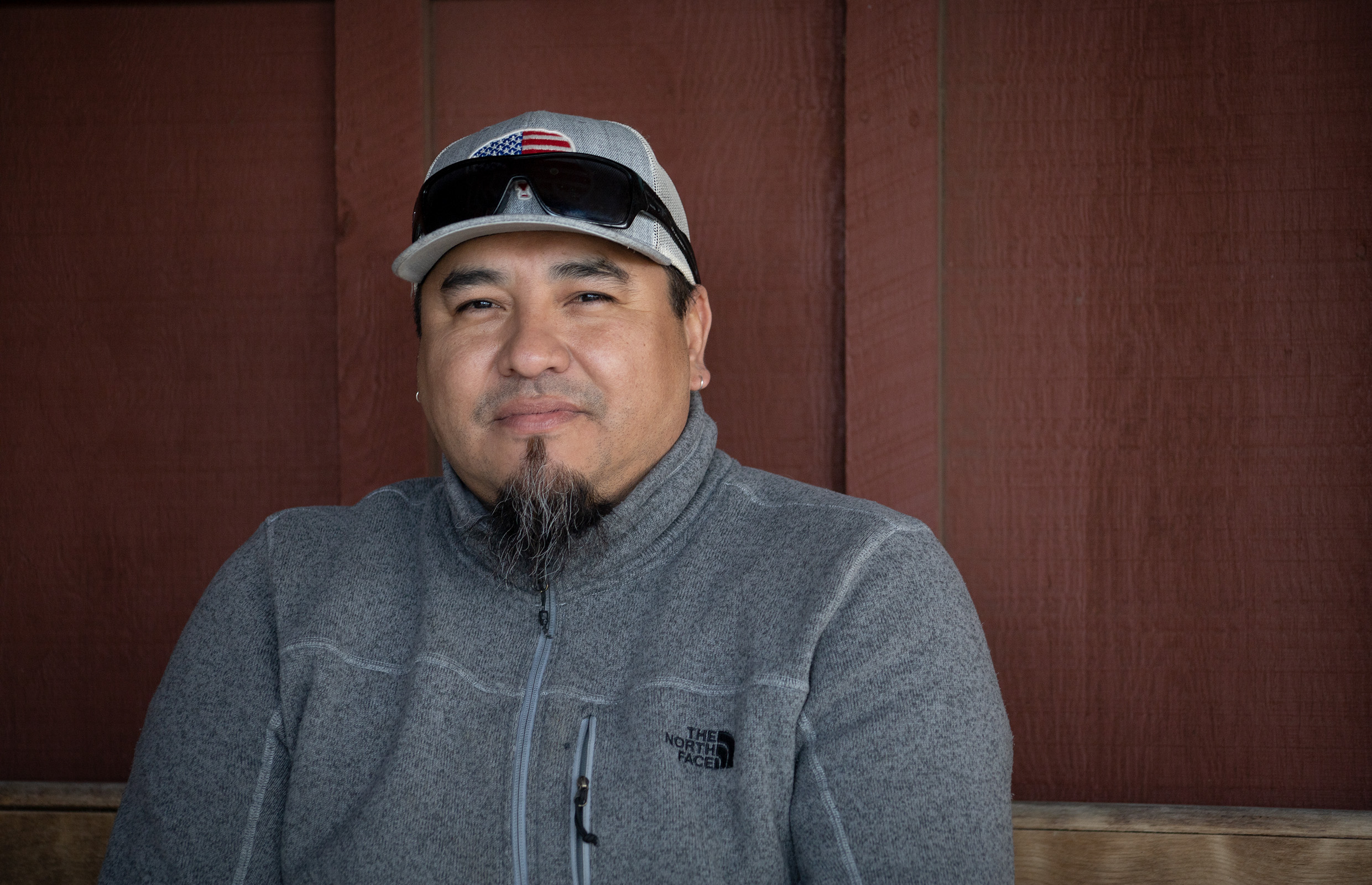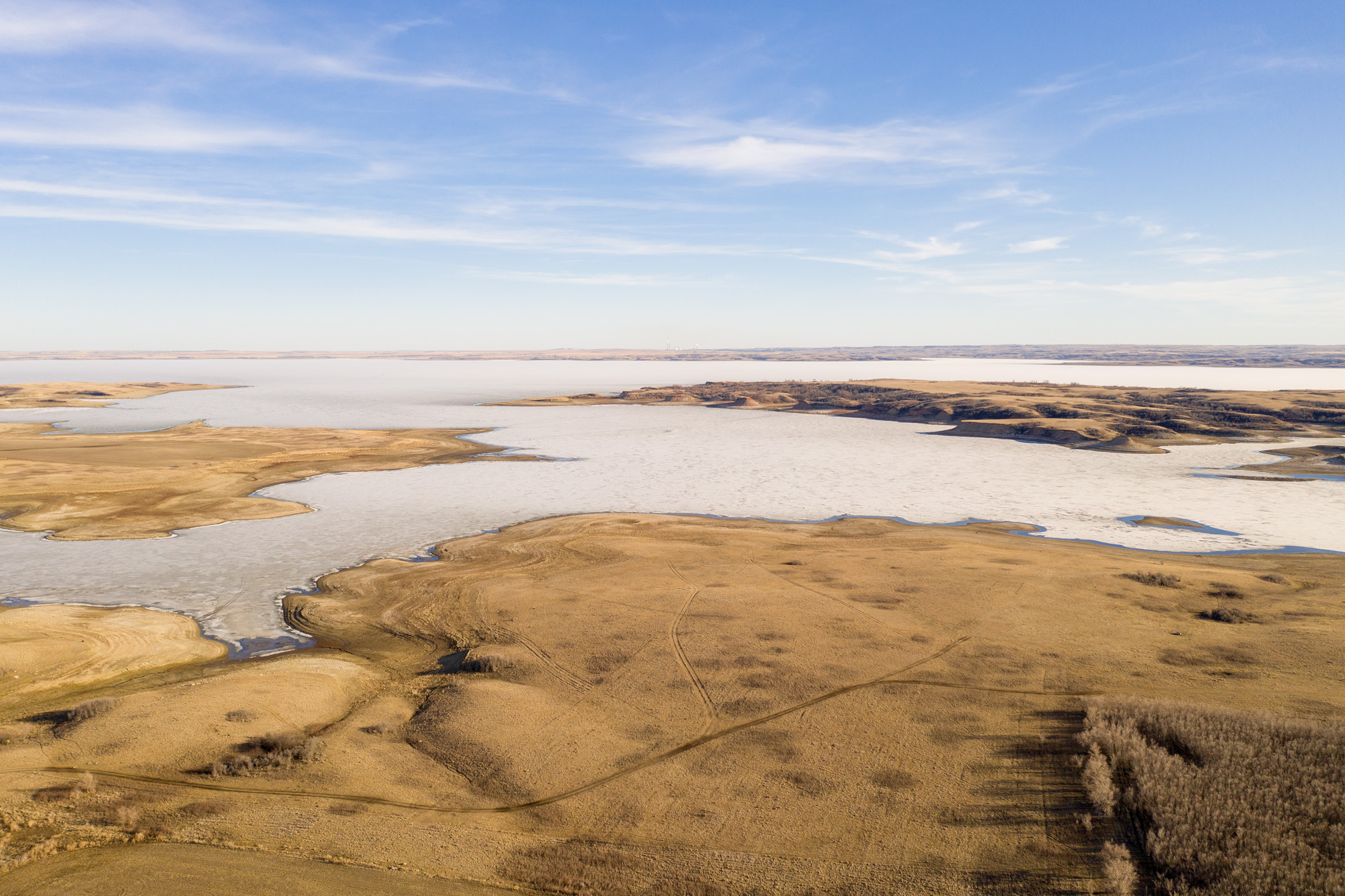
Upholding Traditions
Access to lodgepole pine jeopardizes Apsáalooke teepees
Story by Rosie Ferguson, Photos by Ridley Hudson
Venessa BirdinGround and her partner, Joseph Stewart, have made a side gig from driving into the woods and looking for lodge poles to harvest for teepees.
Last summer, they harvested nearly 20 sets, about 400 trees. When BirdinGround seeks out new poles, she looks for moisture so the bark can be strippped off the logs easily.
With a saturated inner bark, harvesters often slice the base of the tree and peel the exterior by hand in just a few elegant tugs. They also come across trees that have brittle bark that flakes off, a product of extended droughts and hot temperatures.
Drought has made the labor-intensive process of cleaning and preserving the poles more strenuous. Suitable trees for poles have also become more elusive in recent years, which Stewart attributed to a changing climate.
1. Noel Two Leggins drives around the empty Crow Fairgrounds. In August, thousands of tribal members come to set up their tipis with lodgepole pine they harvest every three to four years. 2. Structures and lodgepoles from previous Crow Fairs sit on the fairgrounds in Crow Agency until the next annual fair in August.
“In the places we were going to look to get them, they’re not growing as tall and they’re not as plentiful,” Stewart said.
Climate change and human deforestation has been threatening the availability of quality lodgepole pines that the Apsáalooke use to practice their culture. While the tree is not threatened, the future of lodge- poles in eastern Montana is unclear.
Teepees are still used as shelters for many ceremonies. The shelter belongs to many Plains tribes, who traditionally built them from lodgepole pine trees and bison hides.
On the Crow reservation, the summertime pow-wow and rodeo event Crow Fair is commonly nicknamed as the “Teepee Capital of the World” because it attracts thousands of families who camp in teepees. Crow Fair is also culturally significant as the start of the Apsáalooke New Year.
Adrian Bird, Jr., lead archaeological technician at the Crow Tribal Historic Preservation Office, said Crow Fair sees 1,200 teepees each year. He said the Apsáalooke have adapted to keep their teepees amid changing environmental and societal landscapes.
As the U.S. government took indigenous land, the teepee still survived as a crucial tool and expression of culture, but with some changes. Americans slaughtered millions of bison during the late 1800s, pushing the animal to near extinction and making it impossible to secure enough hides for lodge covers. Now, canvas covers are far more common.
Lodgepole pines are best harvested in the spring before the summer drought. The extra spring moisture makes it easier to remove the bark.
Oral history passed down for generations explains that the Apsáalooke homeland once encompassed the Bighorn, Pryor, Wolf and Absaroka-Beartooth mountain ranges. The three bands of Apsáalooke people had ample places to gather seasonal resources, including lodge poles.
The United States has reduced the reservation by millions of acres in the past 150 years. Still, the reservation remains the state’s largest and sits southeast of Billings.
The Apsáalooke tribe still has legal access to cut lodgepoles for cultural purposes from several U.S. Forest Service-designated harvest sites across the region through the 1868 Fort Laramie treaty, and passed into law by the 2008 Farm Bill. A 2019 lawsuit by a Crow tribal member further opened up more areas to harvest.
Ideally, the trees used for teepee poles need to be tall – around 20 feet or longer – for Crow-style teepees. Trees must also be roughly five inches in diameter and be exceptionally straight.
Philip Higuera, a wildfire ecologist at the University of Montana College of Forestry, said lodgepoles are not going to disappear overnight, but new trees east of the continental divide are working with drier soil that could limit growth.
But the 2021 climate assessment for the Greater Yellowstone Ecosystem showed a 25% decrease in snowfall from 1950 to 2018.
The Montana Climate Assessment predicts changes in snowpack and runoff timing will likely increase the frequency and length of drought during late summer and early fall. As of April 2022, much of Montana and the Crow reservation was locked into severe-to-extreme drought.
Forest Service roads open in the middle of June, but some people said that the harvesting season is shifting earlier into the year, since early-season droughts and summer heat waves make the trees harder to peel.
“If I could go (harvest) in May, I’d go in May,” said Noel Two Leggins, the Crow Tribe’s chief of staff for the Office of the Vice Chairman.
Two Leggins’ grandparents taught him to harvest his teepee poles the right way. Generations of tradition informed this way to prepare a teepee, and Two Leggins finds deep pride in following and sharing this knowledge.
“My dad tells us, ‘You’re Crow. If you don’t practice your belief ways, how can you call yourself a Crow Indian?’” Two Leggins said.
For decades, the tribe harvested teepee poles for Crow Fair mainly in the Bighorn and Pryor mountains. Harvesters said many trees in those mountains are no longer what they look for in worthy poles.



BirdinGround said this year they will have to drive hundreds of miles farther to the Gallatin National Forest near Big Sky, Montana; or the Lewis and Clark National Forest by White Sulphur Springs. She already looked for trees in the Bighorns with little luck.
“That’s quite a commute for us,” BirdinGround said. But it’s a necessary evil. With rising gas prices, she and Stewart will have to charge even more for the poles.
When Two Leggins recently harvest- ed a set of poles, he drove roughly three hours to the Gallatin National Forest near Livingston. At that time, he recalled many other designated harvesting grounds were closed from the threat of early-summer wildfires.
Higuera said a healthy frequency of wildfire can help the trees; mature lodgepole pines need fire to split their cones and release seeds. Fires also clear the forest of extra growth and other potential fuels that threaten established trees.
One risk for lodgepoles is in areas that burn frequently, the cones needed for reproduction could be completely incinerated, Higuera said. Some of these ecosystems could transition into grasslands as they get drier.
“We often end up with forests on the landscape that represent a climate from 200 years ago,” Higuera said. “The closer to warmer, drier areas, the more vulnerable to climate change we are set to experience.”
The cycle is sped up by wildfires, which Higuera and the National Park Service said is more frequent and larger in lodgepole stands.
Harvesters have seen this first hand. More frequent fires mean recently burned stands don’t have time to regenerate before they burn again. If they burn when they’re small and young, Higuera said they often do not reach viable cone-bearing maturity and can’t reproduce.
“Sometimes (wildfire is) a good thing, because then there’s regeneration, but we have to wait for a good 20 years for (the trees) to get to the height we need them,” BirdinGround said.
A SPECIAL PROJECT BY THE UNIVERSITY OF MONTANA SCHOOL OF JOURNALISM
ADDITIONAL FUNDING SUPPORT FROM THE GREATER MONTANA FOUNDATION
READ MORE:

Previous